Biomechanical P ... Slalom Water Skiing R1.pdf - Atrium - University ...
Biomechanical P ... Slalom Water Skiing R1.pdf - Atrium - University ...
Biomechanical P ... Slalom Water Skiing R1.pdf - Atrium - University ...
- No tags were found...
You also want an ePaper? Increase the reach of your titles
YUMPU automatically turns print PDFs into web optimized ePapers that Google loves.
Ski Roll, Ski Acceleration, SkierVelocity (degrees, m/s 2 , kph)85756555453525155-5-15ApproachApex Exit WC NTI00 10 20 30 40 50 60 70 80 90 100Percent of Turn (%)2500200015001000500Rope Load (N)RollSki AccelerationSkier VelocityRope LoadFigure 3: Typical left turn ski roll, ski acceleration, skier velocity and rope load for subject 11, whohad an overall success rate of 88.7%. The five phases of a slalom cut can be identified: approach,apex, exit, wake crossing (WC) and next turn initiation (NTI).The results shown in Figure 3 are a generalization of what was found in large majority ofthe turns from all the skiers. However, the timing of each phase and the resultantperformance parameters can change slightly from one turn to the next. The most obviousof this was occurring from Subject 15. Similar sample profiles from one of their left turnscan be found in Figure 4. The same phases can be identified however the peak parametersare smaller in magnitude and occurring at different times. This supports other results thatindicate Subject 15 is skiing at a lower level than the rest of the subject pool.92
















